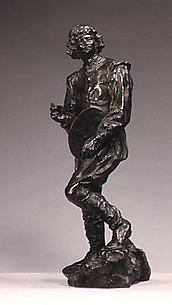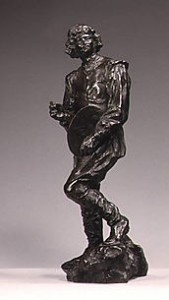
Spotlight on “Study for the Monument to Claude Lorrain”
 Claude Gellée, known as Claude Lorrain, was perhaps the most important seventeenth century French-born painter. He wanted to be a landscape painter when painting landscapes was not considered of great importance, so he disguised his scenes by including figures and by giving the finished paintings historical or narrative titles. In this way he gave his work the “moral weight” required at the time. Two hundred years after Claude’s death, when Rodin was invited to participate in a competition organized by Claude’s native city of Nancy, the sculptor went straight to what he perceived to be Claude’s greatest interest, landscape as revealed by light.
Claude Gellée, known as Claude Lorrain, was perhaps the most important seventeenth century French-born painter. He wanted to be a landscape painter when painting landscapes was not considered of great importance, so he disguised his scenes by including figures and by giving the finished paintings historical or narrative titles. In this way he gave his work the “moral weight” required at the time. Two hundred years after Claude’s death, when Rodin was invited to participate in a competition organized by Claude’s native city of Nancy, the sculptor went straight to what he perceived to be Claude’s greatest interest, landscape as revealed by light.
Meant to be seen high atop a pedestal enlivened at its base by the figure of Apollo driving his chariot pulled by two horses, the figure of Claude is caught in mid-step, twisting his body around to glimpse the rising sun, the source of his delight in nature. Standing below, the viewer would see Claude twisting and turning, his face in awe at the sight. While it seems to move and twist, Rodin’s serpentine figure would literally capture light and thus emulate the intentions of the painter. Claude is depicted as a young man, before he left Nancy for Italy and fame. He is dressed as he would for energetic tramps through the fields to find his landscapes.
Rodin’s sculpture was intended to appeal to the pride the citizens of Nancy had in the achievements of their native son. This was a period when cities all over France were commemorating their contributions to French culture and history – in competition with Paris – by commissioning many monuments to their own people and events.
This Study for the Monument to Claude Lorrain is actually Rodin’s second maquette for the figure. It was this 1889 version that Rodin shared with the competition jury after his 1887/1888 plaster sketch won the commission for him. Rodin scholar John Tancock writes that while this small maquette was not modeled from a living model, the large figure on the finished monument was. Tancock says he prefers this maquette: “There are considerable differences between the sprightly, elegant little figure of the maquette and the clumsy although intense figure of the final monument.”
The Cantor bronze is 20 x 8 x 8 inches. Rodin modeled it in 1889. This cast is by Godard, #5, 1992.





No Comments